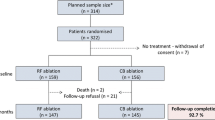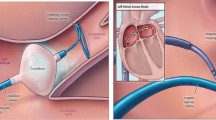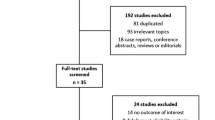Abstract
Background
Laser balloon (LB) and cryoballoon (CB) ablation are two balloon-based catheter ablation technologies used for atrial fibrillation (AF) ablation in recent years. However, the efficacy and the safety of LB ablation in comparison to CB ablation remained indeterminate. We sought to compare these two technologies by conducting meta-analysis of previous studies using both the CB and LB ablation systems for AF ablation.
Methods
We searched electronic scientific databases for studies of LB vs. CB ablation in AF patients. The procedural efficacy was assessed by the success of acute pulmonary vein isolation (PVI) and the 12-month recurrence of any atrial arrhythmia, and the safety was evaluated by the risk of procedure-related complications.
Results
A total of 595 participants (LB, n = 292 vs. CB, n = 303) from eight studies were included in this meta-analysis. Risk of acute PVI failure (risk ratio, RR 95% confidence interval [95% CI] = 2.55 [0.86–7.56], P = 0.09) and atrial arrhythmia recurrence in 12 months (RR [95% CI] = 0.91 [0.64–1.28], P = 0.59) were comparable between LB vs. CB ablation, and LB ablation tended to be more effective than CB ablation in paroxysmal AF patients (RR [95% CI] = 0.70 [0.47–1.03], P = 0.07). Risk of procedure-related complications was similar while LB ablation showed slightly higher risk without statistic significance (LB 13.9% vs. CB 9.3%, RR [95% CI] = 1.52 [0.88–2.64], P = 0.14). Compared with CB ablation, LB ablation led to longer procedure duration (weighted mean differences WMD [95% CI] =29.7 [15.8–43.7], P < 0.001) while similar fluoroscopy duration was observed between these two ablation devices (WMD [95% CI] = − 1.99[− 6.46–2.47], P = 0.38).
Conclusions
LB ablation has a trend toward higher procedural efficacy compared with CB ablation in paroxysmal AF patients. However, longer procedure duration and a statistically non-significant trend of more procedure-related complications were also observed in patients ablated by LB. Further larger comparative randomized trials are warranted to disclose the impact of LB compared with CB for ablation of AF.




Similar content being viewed by others
References
Calkins H, Hindricks G, Cappato R, Kim YH, Saad EB, Aguinaga L, et al. 2017 HRS/EHRA/ECAS/APHRS/SOLAECE expert consensus statement on catheter and surgical ablation of atrial fibrillation. Europace. 2018;20(1):e1–e160. https://doi.org/10.1093/europace/eux274.
Verma A, Jiang C-Y, Betts TR, Chen J, Deisenhofer I, Mantovan R, et al. Approaches to catheter ablation for persistent atrial fibrillation. N Engl J Med. 2015;372(19):1812–22. https://doi.org/10.1056/NEJMoa1408288.
Kuck K-H, Brugada J, Fürnkranz A, Metzner A, Ouyang F, Chun KRJ, et al. Cryoballoon or radiofrequency ablation for paroxysmal atrial fibrillation. N Engl J Med. 2016;374(23):2235–45. https://doi.org/10.1056/NEJMoa1602014.
Packer DL, Kowal RC, Wheelan KR, Irwin JM, Champagne J, Guerra PG, et al. Cryoballoon ablation of pulmonary veins for paroxysmal atrial fibrillation. J Am Coll Cardiol. 2013;61:1713–23. https://doi.org/10.1016/j.jacc.2012.11.064.
Dukkipati SR, Cuoco F, Kutinsky I, Aryana A, Bahnson TD, Lakkireddy D, et al. Pulmonary vein isolation using the visually guided laser balloon: a prospective, multicenter, and randomized comparison to standard radiofrequency ablation. J Am Coll Cardiol. 2015;66(12):1350–60. https://doi.org/10.1016/j.jacc.2015.07.036.
Dukkipati SR, Woollett I, Mc EH, Bohmer MC, Doshi SK, Gerstenfeld EP, et al. Pulmonary vein isolation using the visually guided laser balloon: results of the U.S. feasibility study. J Cardiovasc Electrophysiol. 2015;26:944–9. https://doi.org/10.1111/jce.12727.
Schmidt B, Neuzil P, Luik A, Osca Asensi J, Schrickel JW, Deneke T, et al. Laser balloon or wide-area circumferential irrigated radiofrequency ablation for persistent atrial fibrillation: a multicenter prospective randomized study. Circ Arrhythm Electrophysiol. 2017;10(12):e005767. https://doi.org/10.1161/CIRCEP.117.005767.
Bordignon S, Chun KR, Gunawardene M, Fuernkranz A, Urban V, Schulte-Hahn B, et al. Comparison of balloon catheter ablation technologies for pulmonary vein isolation: the laser versus cryo study. J Cardiovasc Electrophysiol. 2013;24(9):987–94. https://doi.org/10.1111/jce.12192.
Schmidt B, Gunawardene M, Krieg D, Bordignon S, Furnkranz A, Kulikoglu M, et al. A prospective randomized single-center study on the risk of asymptomatic cerebral lesions comparing irrigated radiofrequency current ablation with the cryoballoon and the laser balloon. J Cardiovasc Electrophysiol. 2013;24(8):869–74. https://doi.org/10.1111/jce.12151.
Kumar N, Blaauw Y, Timmermans C, Pison L, Vernooy K, Crijns H. Adenosine testing after second-generation balloon devices (cryothermal and laser) mediated pulmonary vein ablation for atrial fibrillation. J Interv Card Electrophysiol. 2014;41(1):91–7. https://doi.org/10.1007/s10840-014-9921-z.
Wissner E, Metzner A, Neuzil P, Petru J, Skoda J, Sediva L, et al. Asymptomatic brain lesions following laserballoon-based pulmonary vein isolation. Europace. 2014;16(2):214–9. https://doi.org/10.1093/europace/eut250.
Casella M, Dello Russo A, Russo E, Al-Mohani G, Santangeli P, Riva S, et al. Biomarkers of myocardial injury with different energy sources for atrial fibrillation catheter ablation. Cardiol J. 2014;21:516–23. https://doi.org/10.5603/CJ.a2013.0153.
Tsyganov A, Petru J, Skoda J, Sediva L, Hala P, Weichet J, et al. Anatomical predictors for successful pulmonary vein isolation using balloon-based technologies in atrial fibrillation. J Interv Card Electrophysiol. 2015;44(3):265–71. https://doi.org/10.1007/s10840-015-0068-3.
Stockigt F, Kohlmann AT, Linhart M, Nickenig G, Andrie RP, Beiert T, et al. Laserballoon and cryoballoon pulmonary vein isolation in persistent and longstanding persistent atrial fibrillation. Pacing Clin Electrophysiol. 2016;39(10):1099–107. https://doi.org/10.1111/pace.12929.
Perrotta L, Konstantinou A, Bordignon S, Fuernkranz A, Dugo D, Chun KJ, et al. What is the acute antral lesion size after pulmonary vein isolation using different balloon ablation technologies? Circ J. 2017;81(2):172–9. https://doi.org/10.1253/circj.CJ-16-0345.
Gal P, Ooms JF, Ottervanger JP, Smit JJ, Adiyaman A, Ramdat Misier AR, et al. Association between pulmonary vein orientation and atrial fibrillation-free survival in patients undergoing endoscopic laser balloon ablation. Eur Heart J Cardiovasc Imaging. 2015;16(7):799–806. https://doi.org/10.1093/ehjci/jeu321.
Perrotta L, Bordignon S, Dugo D, Furnkranz A, Chun KJ, Schmidt B. How to learn pulmonary vein isolation with a novel ablation device: learning curve effects using the endoscopic ablation system. J Cardiovasc Electrophysiol. 2014;25(12):1293–8. https://doi.org/10.1111/jce.12491.
Dukkipati SR, Neuzil P, Kautzner J, Petru J, Wichterle D, Skoda J, et al. The durability of pulmonary vein isolation using the visually guided laser balloon catheter: multicenter results of pulmonary vein remapping studies. Heart Rhythm. 2012;9(6):919–25. https://doi.org/10.1016/j.hrthm.2012.01.019.
Figueras IVRM, Margulescu AD, Benito EM, Alarcon F, Enomoto N, Prat-Gonzalez S, et al. Postprocedural LGE-CMR comparison of laser and radiofrequency ablation lesions after pulmonary vein isolation. J Cardiovasc Electrophysiol. 2018;29(8):1065–72. https://doi.org/10.1111/jce.13616.
Bordignon S, Chun KR, Gunawardene M, Urban V, Kulikoglu M, Miehm K, et al. Energy titration strategies with the endoscopic ablation system: lessons from the high-dose vs. low-dose laser ablation study. Europace. 2013;15(5):685–9. https://doi.org/10.1093/europace/eus352.
Okumura Y, Henz BD, Bunch TJ, Dalegrave C, Johnson SB, Packer DL. Distortion of right superior pulmonary vein anatomy by balloon catheters as a contributor to phrenic nerve injury. J Cardiovasc Electrophysiol. 2009;20(10):1151–7. https://doi.org/10.1111/j.1540-8167.2009.01495.x.
MRA-Ohoo R, Zheng Q, Doros G. Laser balloon ablation for AF: a systematic review and meta-analysis. J Cardiovasc Electrophysiol. 2018. https://doi.org/10.1111/jce.13698.
Neumann T, Vogt J, Schumacher B, Dorszewski A, Kuniss M, Neuser H, et al. Circumferential pulmonary vein isolation with the cryoballoon technique results from a prospective 3-center study. J Am Coll Cardiol. 2008;52(4):273–8. https://doi.org/10.1016/j.jacc.2008.04.021.
Straube F, Dorwarth U, Vogt J, Kuniss M, Heinz Kuck K, Tebbenjohanns J, et al. Differences of two cryoballoon generations: insights from the prospective multicentre, multinational FREEZE Cohort Substudy. Europace. 2014;16(10):1434–42. https://doi.org/10.1093/europace/euu162.
Metzner A, Wissner E, Lin T, Ouyang F, Kuck KH. Balloon devices for atrial fibrillation therapy. Arrhythm Electrophysiol Rev. 2015;4(1):58–61. https://doi.org/10.15420/aer.2015.4.1.58.
Funding
This work was supported by the Science and Technology Commission of Shanghai Municipality (no. 16140904602) and National Natural Science Foundation of China (81470450, 81470451, 81600270).
Author information
Authors and Affiliations
Corresponding author
Ethics declarations
Conflict of interest
The authors declare that they have no conflict of interest.
Ethical approval
Ethical approval was not required for this study design.
Rights and permissions
About this article
Cite this article
Wei, Y., Zhang, N., Jin, Q. et al. Comparison of efficacy and safety of laser balloon and cryoballoon ablation for atrial fibrillation—a meta-analysis. J Interv Card Electrophysiol 54, 237–245 (2019). https://doi.org/10.1007/s10840-018-0474-4
Received:
Accepted:
Published:
Issue Date:
DOI: https://doi.org/10.1007/s10840-018-0474-4




